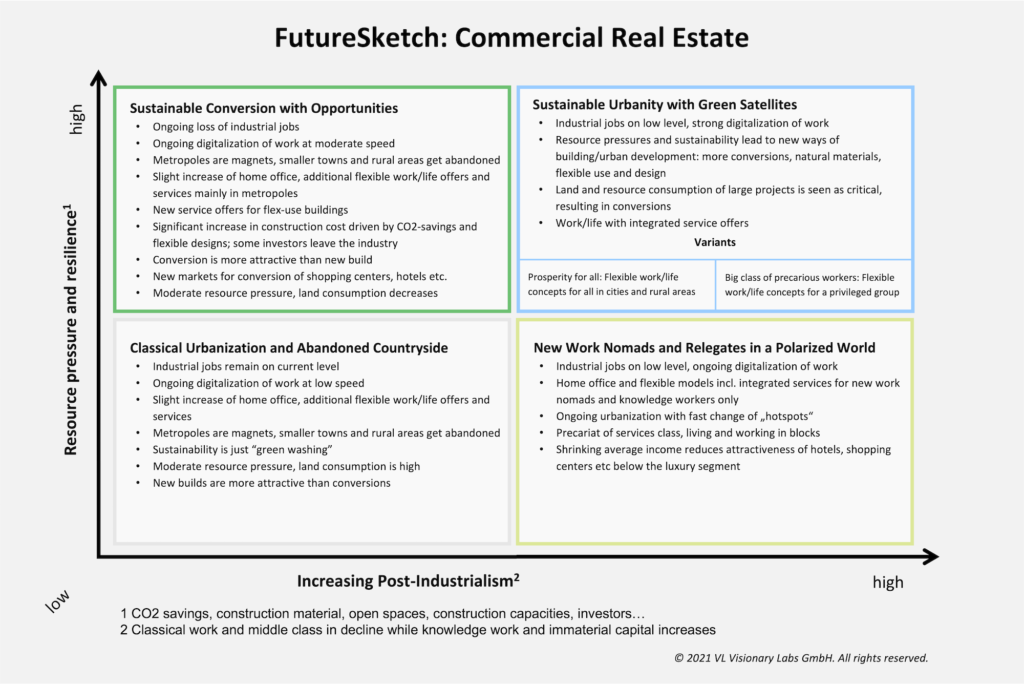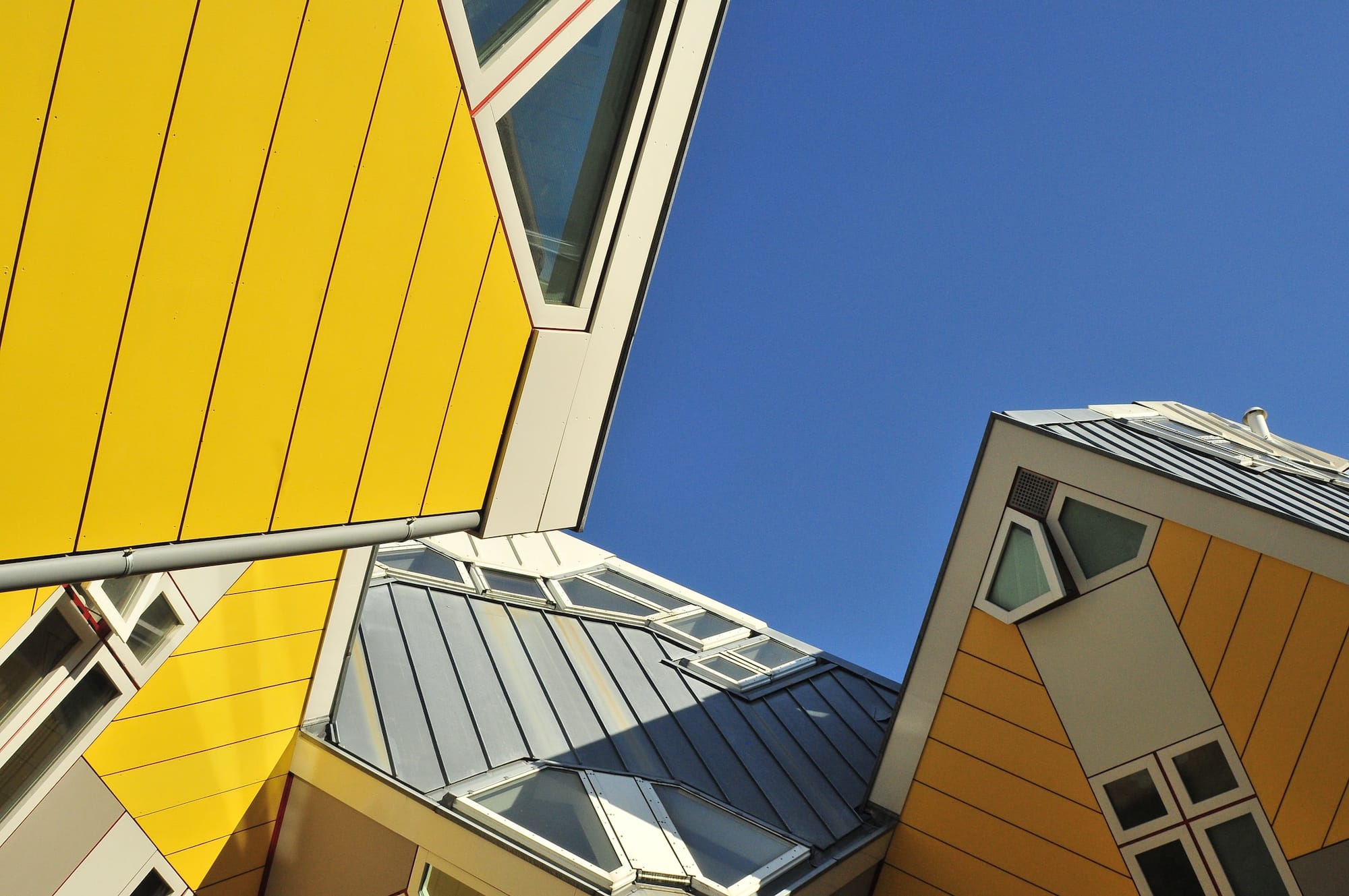For many construction projects, the previous assumptions and concepts seem questionable. Large projects such as hotel complexes and shopping centers are being re-evaluated, as failures or low occupancy rates may result in a negative return on investment. In tourism, the customer preferences shifted towards destinations within the country, outside the metropolitan areas and to shorter trips. And shopping behavior has shifted significantly toward online, leading to declines in retail and on the other hand to new demands for logistics. Of course, it remains to be seen to what extent these trends will prevail or revert back. However, these structural changes – which have already been underway before COVID – have now significantly accelerated.
Office buildings have also become questionable in their original use as a permanent workplace, as many companies and employees have discovered the benefits of working from home. Despite that, the future behavior of companies and organizations when it comes to working from home is unclear. The propensity toward physical control will not disappear overnight, nor will the need for in-person collaboration and direct exchange. On the other hand, there is great potential for savings in office rent, catering and commuting, as well as an increase in the quality of life for employees and their families. In addition, new mobility concepts will further change the way we work (and play). And they will certainly give rise to new office concepts.
In summary, we expect an increasing demand for sustainability, modularity, and an ongoing movement into the post-industrial era with more digital work. This will lead to significant changes in our cityscapes, triggered by new working environments, changing shopping behaviors, more complex logistics and enhanced mobility concepts.
Even if we will see new pandemics or just new waves at regular intervals, which is questionable, after one and a half years we should have learned by now how to react more efficiently. Accordingly, we will hardly see a 1:1 repetition. On the other hand, it is unlikely that the outlined changes will stop and that we will return to pre-crisis levels.
Building on this assessment, we have built a future matrix (see graphic) using the dimensions “resource pressure” and “increase in post-industrialism”. The resource pressure comes not only from the necessary C02 measures demanded by legislators and consumers. There are also current and further resource bottlenecks such as open spaces in cities, construction capacities, building materials, investors, etc. Let’s look at the scenarios in detail:

Classic urbanization and abandoned countryside
In the baseline of our considerations, little has changed. Urbanization and abandonment of rural areas continue to be the defining trends. Offices are largely used as traditional workspaces. In addition, we see more flexibility in the utilization of buildings as well as an increase in service concepts as we already know them (like flexdesk models). However, these developments will largely be limited to metropolitan areas. Accordingly, the already known problems will become more intense, i.e. uncertainties increase, investments become more difficult, and sustainability requirements become greater.
Sustainable remodeling with opportunities
In this scenario, we observe increasing pressure for sustainable construction and the need for more resilient projects, which is driving up construction cost and is making conversion projects more attractive compared to new builds. Investments are more complex and some of the former blockbusters such as shopping centers and hotel complexes are being repurposed into e.g. flexible work/residential facilities, to become more resilient. The work concepts are the already known models with some add-on of flexible work/housing offerings and service concepts, largely in metropolitan areas.
Work nomads and relegates in a polarized world
The world of work will shift further toward services but only a privileged segment of knowledge workers will benefit. New work/life formats are being developed and existing office spaces are being adapted for this group. The risk lies in the nomadism of knowledge workers, where the attractiveness of cities can rapidly change, also caused by e.g. changing tax laws and mobility concepts. The declining income of the precarious service class makes larger projects such as shopping centers below the luxury segment less attractive, which leads to reallocations.
Sustainable urbanity with green satellites
In this scenario, work is a service, as the world has become increasingly servitized. Societies have adapted and major income inequalities have been reduced or mitigated. Global resource pressures result in new ways of building and urban design, with a strong focus on reuse, flexibility, and sustainable building materials. Old large-scale building projects are repurposed when possible. Working and living are treated in an integrated way (including mobility). Working/living is covered by new service packages, such as integrated mobility, schools, and shopping, some of which are linked to buildings. Provided that the lower income classes will benefit as well, these models will extend beyond the cities into rural life. Should significant inequalities persist, we will see this development in metropolitan areas and in a few select rural areas for a wealthy few. In these conditions, old projects such as shopping centers and hotel complexes are no longer viable and will be re-purposed.
Conclusion
In the long term, the future of the commercial real estate will be strongly determined by the speed at which we move into a service society. During that process, we will leave behind classic forms of use, without having a final understanding what the new forms will look like. As construction projects are usually long-term, the industry needs new ways to tackle flexible (re-)construction (including service concepts). The requirements for sustainability, on the other hand, have clear contours. Their implementation will be shaped by rapidly changing regulations and technical progress in building materials and digitalization. In summary, the industry is facing challenging times.
What do you think of this FutureSketch? We look forward to your comments.
Do you want to be prepared as well? We help you develop a company-specific view of the future: Together, we analyze current trends and influencing factors. Based on these we jointly derive detailed future scenarios. And these scenarios are the basis on which we develop concrete innovation ideas and an innovation roadmap. Contact us at hello@visionarylabs.io, via the form below or via our social media channels.

